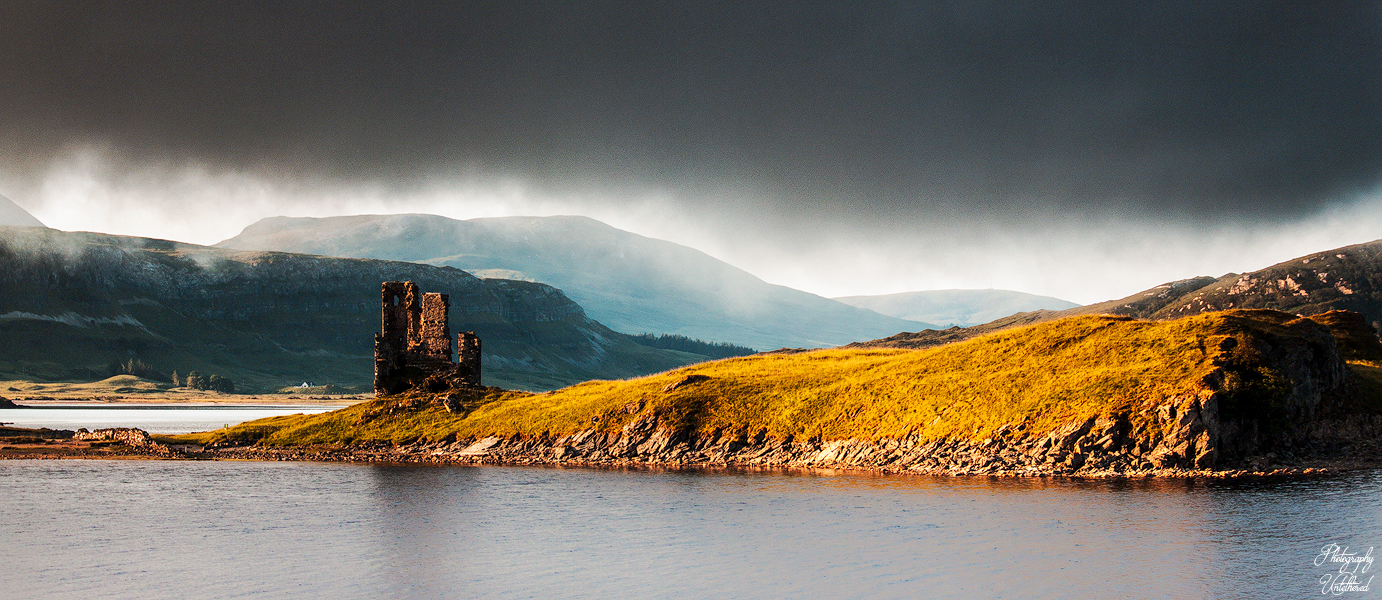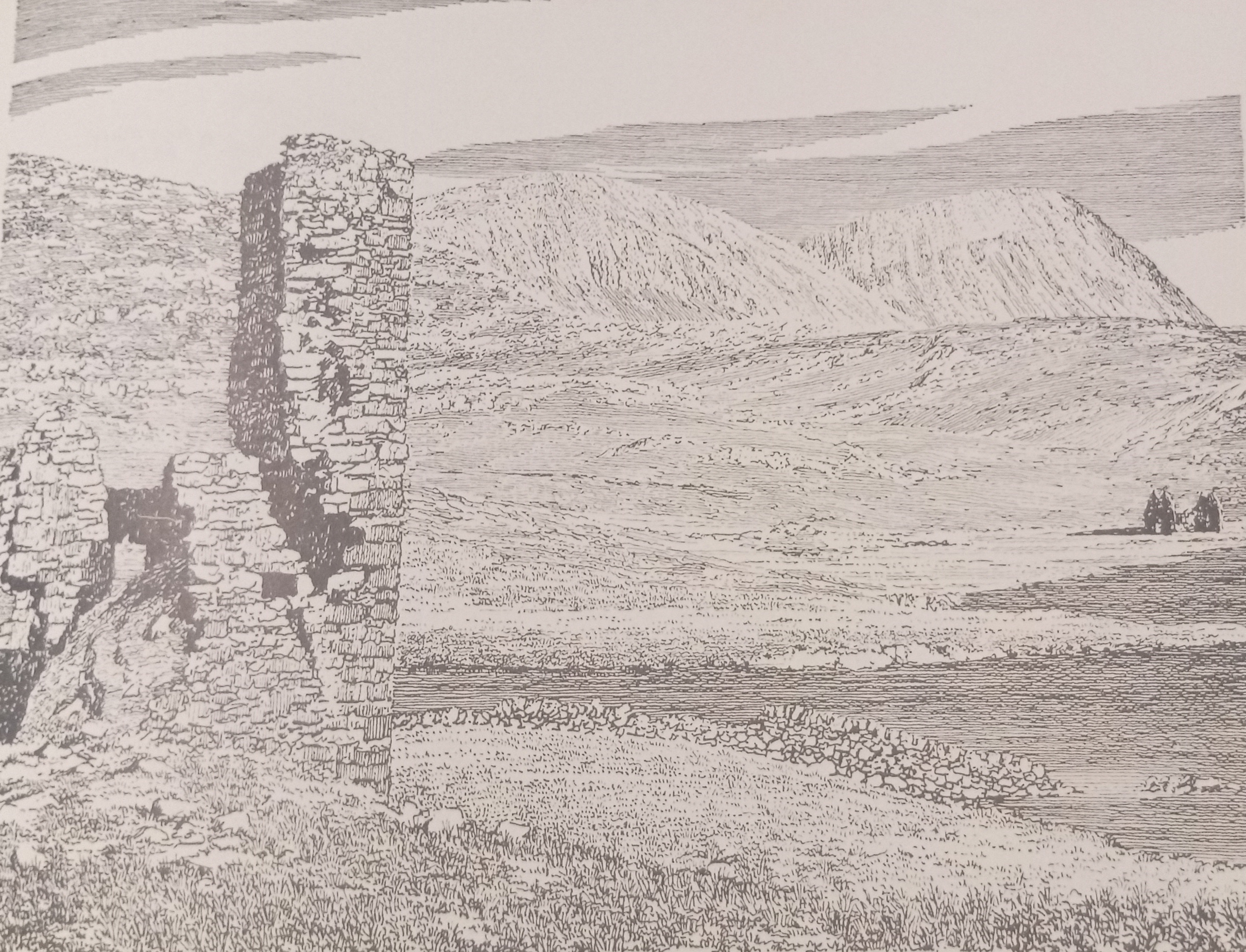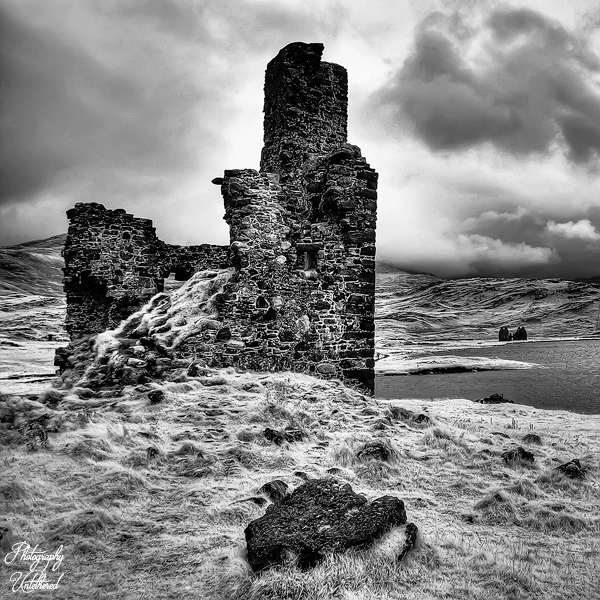Ardvreck Castle “Àrd Bhric.” Loch Assynt, Sutherland, Scotland
Ardvreck Castle: A Haunted Ruin of History
Ardvreck Castle, dating back to the 15th century, is a hauntingly beautiful ruin that stands upon a rocky promontory in Loch Assynt, Sutherland, Scotland. This remote and picturesque location in the Scottish Highlands has witnessed centuries of turbulent history, marked by clan rivalries, betrayals, and dramatic events that have left an indelible mark on its crumbling stones and the surrounding landscape. The castle’s history is intertwined with tales of violence, sieges, and tragic figures, making it a focal point for both historical interest and paranormal legends.
Caisteal Àrd Bhric:
Ardvreck, in its original Gàidhlig form, is “Àrd Bhric.” In Gàidhlig, “Àrd” means “height,” “point,” or “promontory.”
Phonetically, “àrd” can be broken down as follows:
The “A” sound is typically pronounced like the “a” in the English words “barrage” or “hard,” representing a broad ‘a’ sound.
The “rd” sound in Gàidhlig can differ from English. It is somewhat similar to the “rd” in “hard,” but its exact articulation may vary by dialect. In some regions, such as Harris, North Uist, northwest Skye, Tiree, Mull, and Lochaber, you may hear an intrusive /s/ or /ʃ/ sound associated with “rd,” a feature that has spread to other areas.
The second element, “Bhric,” is a lenited form of the Gaelic word “breac,” which means “speckled.” Lenition is a common grammatical process in Gàidhlig, where the initial consonant of a word changes—often indicated by the addition of an ‘h’ after the consonant to soften its sound. In this case, the ‘b’ becomes ‘bh.’ The pronunciation of “bhric” in Gàidhlig is approximately “vreech-k.”
The term “speckled” refers to a prominent mass of land that projects into a low-lying area, often extending into the sea and characterised by a spotted appearance.
Ardvreck Castle: Origins and Early History
The castle’s origins trace back to the late 15th century, with its initial construction attributed to Angus Mor III. It began as a simple rectangular block, three or four storeys high, designed as a strategic stronghold for the MacLeods of Assynt. Around a century later, Donald Ban IX enhanced the castle’s accommodation by adding a tower, vaulted cellars, and a vault over the great hall, reflecting the architectural trends of the time. Despite these improvements, Ardvreck remained relatively small, necessitating additional buildings for kitchens, servants’ quarters, and stables. The stone wall cutting off the promontory followed an earlier rampart, augmenting the castle’s naturally defensive position.
Ardvreck Castle: The Betrayal of Montrose
Ardvreck Castle played a significant role in Scottish history, particularly during the War of Three Kingdoms. In 1650, James Graham, 1st Marquess of Montrose, a Royalist leader, sought refuge at Ardvreck after his defeat at the Battle of Carbisdale. Accounts vary, but it is widely believed that Montrose was betrayed by the MacLeods of Assynt, either by Neil MacLeod himself or by his wife, Christine, who allegedly tricked him into the castle dungeon. Montrose was subsequently handed over to the Covenanters, transported to Edinburgh, and executed on May 21, 1650, by hanging, drawing, and quartering. This act of betrayal is a central theme in the castle’s lore.
from To His Mistress
My dear and only Love, I pray
This noble World of thee,
Be govern’d by no other Sway
But purest Monarchie.
For if Confusion have a Part,
Which vertuous Souls abhore,
And hold a Synod in thy Heart,
I’ll never love thee more.
Like Alexander I will reign,
And I will reign alone,
My Thoughts shall evermore disdain
A Rival on my Throne.
He either fears his Fate too much,
Or his Deserts are small,
That puts it not unto the Touch,
To win or lose it all. …
But if thou wilt be constant then,
And faithful of thy Word,
I’ll make thee glorious by my Pen,
And famous by my Sword.
I’ll serve thee in such noble Ways
Was never heard before:
I’ll crown and deck thee all with Bays,
And love thee evermore.
James Graham, First Marquis of Montrose (1612 – 1650)
Fall of the MacLeods and the Rise of the MacKenzies
The MacLeod ownership of Ardvreck came to an end in 1672 when the MacKenzies of Wester Ross besieged the castle for 14 days and ultimately captured it. The MacKenzies, who had long coveted the MacLeod lands, used Montrose’s betrayal as a pretext for their attack. The MacKenzies themselves, however, did not reside in Ardvreck for long. Finding the castle cheerless and uncomfortable, Kenneth MacKenzie’s wife, Frances, persuaded him to build a more modern and comfortable dwelling nearby. This led to the construction of Calda House in 1726, located within sight of Ardvreck Castle. Much of the stone used for Calda House was repurposed from the abandoned Ardvreck Castle.
Calda House, however, also met a tragic end. Due to mounting debts and the MacKenzies’ Jacobite leanings, the house faced financial ruin. In 1737, Calda House was destroyed by fire. One legend attributes the fire to divine wrath, claiming it broke out during a Saturday night celebration that extended into the Sabbath, with all inhabitants perishing except for a piper who refused to play past midnight. A more pragmatic account suggests that MacKenzie clan supporters deliberately torched the house to prevent it from falling into the hands of their rivals, the Earl of Sutherland. Today, both Ardvreck Castle and Calda House stand as evocative ruins, testaments to a dramatic past.
Ardvreck Castle’s Demise and Hauntings:
The castle’s ultimate destruction is often attributed to a lightning strike in 1795, which largely destroyed it. This natural event marked the final act of violence against the ancient stronghold. Ardvreck Castle and Calda House are now protected as Scheduled Monuments by Historic Environment Scotland, preserving their historical and legendary significance. Visitors can explore the ruins, walk the grounds, and immerse themselves in the rich history and eerie atmosphere of this remarkable Scottish landmark.
Ardvreck Castle is renowned for its ghostly inhabitants and legends. One of the most prominent is the weeping daughter of a MacLeod chief. The tale recounts that she was tricked into marrying the Devil as part of a pact to save her father’s castle. In despair, she threw herself from a castle window into Loch Assynt and drowned. Her mournful sobs are said to be heard when mists shroud the loch, and her ghostlike apparition is said to have been walking along the beach; whether a dram or two was involved in this incident, one can only guess. Maybe not the place for an overnight bivi!
A variation of this legend suggests that instead of dying, she transformed into the “Mermaid of Assynt” or a Selkie, hiding in underwater caves. Her tears are said to cause the loch’s water levels to rise.
Another spectral resident is a tall man dressed in grey, often seen wandering the ruins or standing blankly in the tower. Many believe this to be the ghost of James Graham, the Marquess of Montrose, forever tied to the site of his betrayal. Calda House also has its share of paranormal activity, with reports of an unknown ghostly woman, strange lights at night, and phantom car headlights.
My Story: The Crofters Cottage
It was October, and the weather was a contrast of sunshine and showers—not cold, just nice. The light and colours were amazing, making it one of my most memorable family holidays. We stayed in a traditional old stone crofter’s cottage on the outskirts of Lochinver—a truly “olde-worlde” experience. The owner, a widowed gentleman and a former walker, had lost his ability to venture into the hills due to his age.
The cottage was filled with a lifetime’s array of memorabilia, clearly a place that had brought him and his late wife many years of happiness. I couldn’t help but think that, now widowed, spending time there must be quite a melancholic experience for him, with a flood of bittersweet memories. In truth, probably the reason he rarely visited.
In any case, he had asked us to close the cottage up for the winter and kindly allowed us to stop for a week free of charge. I remember the dark evenings in the cottage. Sitting in an antiquated but snug chair under the dim living room lighting. The quiet, broken only by the crackle and spit of the log fire, while the aromatic smell of pine permeated the air.
A vast array of maps and walking literature gathered dust on the shelves and mantelpiece. With a dram in one hand and a map in the other, I couldn’t think of anywhere I’d rather be.
No mobile signal, no internet, no TV. Completely cut off from the modern world.
Bliss.
Ardvreck Castle & Wainwright:
I came across this fascinating old Wainwright book, where I found a pencil drawing of Ardvreck Castle by Wainwright himself. I was keen to see the accuracy of the sketch from the viewpoint where Wainwright had crafted his drawing.
Wainwright’s pencil drawing seemed to enhance the castle’s mythical appearance. So to affect the same impression, I wanted to capture the castle from the same angle. Using the medium of infrared, the image below is the result of that effort.
Visit Ardvreck Castle:
Ardvreck Castle is located in Sutherland, in the Scottish Highlands, specifically on the eastern side of Loch Assynt. It is situated near the A837 road and is a notable stop along the North Coast 500 route
To reach Ardvreck Castle, the most recommended method is by driving independently due to the area’s remote nature.
From Inverness: A day trip from Inverness to Ardvreck Castle takes approximately two hours of driving. The route offers scenic mountainous views as one approaches Loch Assynt. When nearing Loch Assynt, visitors will see the castle in the distance and will pass the ruins of Calda House on their left, indicating they are on the correct path.
Via the North Coast 500 (NC500) loop: If travelling the NC500, Ardvreck Castle is directly on the main loop. Those driving south from areas like Durness should follow the A894 road down to Loch Assynt. After crossing the Kylesku bridge, the castle is about a 15-minute drive away. The castle is located between Wester Ross and the North Coast, within the Coigach and Assynt reserves.
Parking and Access: There is a small car park near Ardvreck Castle for visitors. From the parking area, a short walk of approximately 5 minutes is required to reach the castle ruins. The path to the castle has been improved for better access.
Nearby Locations: The castle is a short drive from Ben More mountain. Other nearby points of interest include the Wailing Widow falls and the charming town of Ullapool, which is a great place for lunch and offers views of Loch Broom. Ullapool is also a recommended base for accommodation when visiting Ardvreck Castle. The area is part of the North West Highlands Geopark, known for its geological features like the Deep Freeze Mountains and Stac Pollaidh.
“Take only memories, leave only footprints.”
The website is self-funded, and my work is free. All profits from the sites product links go to SightSavers; if you have enjoyed any aspect of this site please consider a giving a donation here. No one should go blind from avoidable causes. How many people’s sight will you help us save today?
Fragmented Memory 🙂



